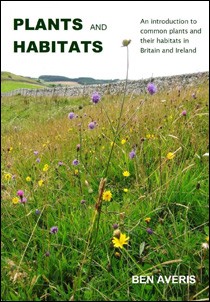Plants and Habitats by Ben Averis

The book appears to have two (interlinked) aims: to help with identification, and to set the plants in their habitat and landscape contexts. In terms of the former, the approach to identification is very much based on common sense, focusing on particularly useful features for quick recognition. This works well since, in not attempting to be 100% comprehensive, it does not need to include excessive detail of minor points simply to rule out rare and unlikely alternatives. The identifications are based, so far as possible, around non-flower characteristics, with the author exhorting us not to be afraid of tackling grass identification even when no flowering heads are present. Technical botanical terms are kept to a minimum, although obviously some are necessary. The text is relatively sparse but focused as appropriate to the species, and is refreshingly personal and non-repetitive. The photos are well selected, not necessarily to be beautiful but to be useful, and they often portray plant jizz better than in some of the traditional guides.
The second theme of the books is that of habitats, and again the experience and indeed enthusiasm of the author for the subject comes across well. The habitat elements of the book are also tackled in a variable level of detail, as appropriate; many species warrant a few words while, in contrast, seven pages of detail are devoted to covering the condition of heather. For many species, reference is given to the principal National Vegetation Communities in which they are found. In addition, notes on human-related matters are included throughout, such as whether species are introduced and how they respond to grazing pressure.
Given that the author lives and works in Scotland, and given that the book was supported by Scottish Natural Heritage and Forestry Commission Scotland, it is unsurprising that the book is somewhat biased to more northerly habitats and species. I found this refreshing and it in no way detracts from the value of the book to naturalists in the south of Britain. I would strongly recommend this book to anyone interested in developing their knowledge of our native flora and the way it relates to our landscapes.
ISBN: 9780957608108


